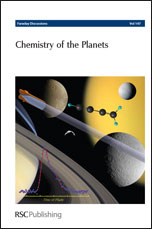Laboratory data have a dual and critical role in interpreting information obtained from the Cassini spacecraft in its passes through the Titan ionosphere. Firstly, in situ mass spectra are obtained by Cassini and their conversion into atmospheric molecular composition requires chemical modeling to create agreement between the observed mass spectra and those determined from the models. Secondly, once agreement is obtained, then the chemical model can be considered to represent the evolution of the Titan atmosphere. As a contribution to these endeavors in the past, laboratory measurements have been made in the Selected Ion Flow Tube (SIFT) of the reactions of a series of ring molecules with the important ionospheric ion CH3+. These reactions showed that a dominant reaction channel is association. In the present study, this work has been extended to reactions of another important Titan ion C3H3+. These ion–molecule reactions have also been studied at room temperature using a SIFT. Reactions have been studied in detail with benzene, toluene and pyridine and show again that association is very important. The loss of ionization in the ionosphere is then controlled by electron–ion dissociative recombination of the association ions and their progeny. The recombination reactions have been studied as a function of temperature (300 to 550 K) using a flowing afterglow. These combined data have been used to develop a subset of the chemistry and test its viability. They have indicated that association of the important Titan ions with the abundant nitrogen, followed by switching of the nitrogen for the ring compounds, can build up larger species, perhaps resulting in multi-rings. Recombination of such species can affect the ionization balance and provide species which can contribute to the parallel neutral chemistry. Species are suggested that should be looked for in the in situ mass spectra.
You have access to this article
 Please wait while we load your content...
Something went wrong. Try again?
Please wait while we load your content...
Something went wrong. Try again?

 Please wait while we load your content...
Please wait while we load your content...